University of Greenwich Leadership Report: Self and Group Analysis
VerifiedAdded on 2021/08/10
|22
|5218
|125
Report
AI Summary
This report, submitted by a University of Greenwich student, analyzes leadership skills and experiences within the context of a Business Management program. The report begins with a self-assessment based on the Belbin Team Roles model, identifying the student's strengths and weaknesses as a 'Completer'. It then delves into experiences in leadership roles, highlighting problems encountered such as lack of emotional control and miscommunication, along with the solutions applied. The report reflects on group work, discussing the application of leadership theories like Transformational Leadership, Negotiations, and Utility Leadership, and provides a project schedule with stages of preparation, brainstorming, finalizing, and slide preparation. The student assesses the contribution levels of group members and the changing motivations within the work environment. Finally, the report details the student's self-development journey, outlining achievements in communication skills, emotional control, and new leadership skills, and concludes with the type of leader the student aspires to become. The report includes references, appendices with a weekly journal and a table of descriptors of team members contributions, and figures illustrating the project schedule and timeline.

University of Greenwich (UOG)
Bachelor of Arts (Hons) Business Management (Top Up)
ASSIGNMENT / PROJECT COVER SHEET
(to be completed individually by student)
UOG ID Number 001163775-7
Course Specialization
(*Please delete whichever is not applicable)
*Marketing and Sales
Subject Code/Name BUSI 1323/ Leadership in Organisations
Assignment Title Individual Report (80%)
Lecturer/Supervisor Ms. Natasha
Word count 2401
DECLARATION
I, the above named student, confirm that by submitting, or causing the attached assignment
to be submitted, I have not plagiarized any other person’s work in this assignment and
except where appropriately acknowledged, this assignment is my own work, has been
expressed in my own words, and has not previously been submitted for assessment.
pg. 1
Bachelor of Arts (Hons) Business Management (Top Up)
ASSIGNMENT / PROJECT COVER SHEET
(to be completed individually by student)
UOG ID Number 001163775-7
Course Specialization
(*Please delete whichever is not applicable)
*Marketing and Sales
Subject Code/Name BUSI 1323/ Leadership in Organisations
Assignment Title Individual Report (80%)
Lecturer/Supervisor Ms. Natasha
Word count 2401
DECLARATION
I, the above named student, confirm that by submitting, or causing the attached assignment
to be submitted, I have not plagiarized any other person’s work in this assignment and
except where appropriately acknowledged, this assignment is my own work, has been
expressed in my own words, and has not previously been submitted for assessment.
pg. 1
Paraphrase This Document
Need a fresh take? Get an instant paraphrase of this document with our AI Paraphraser
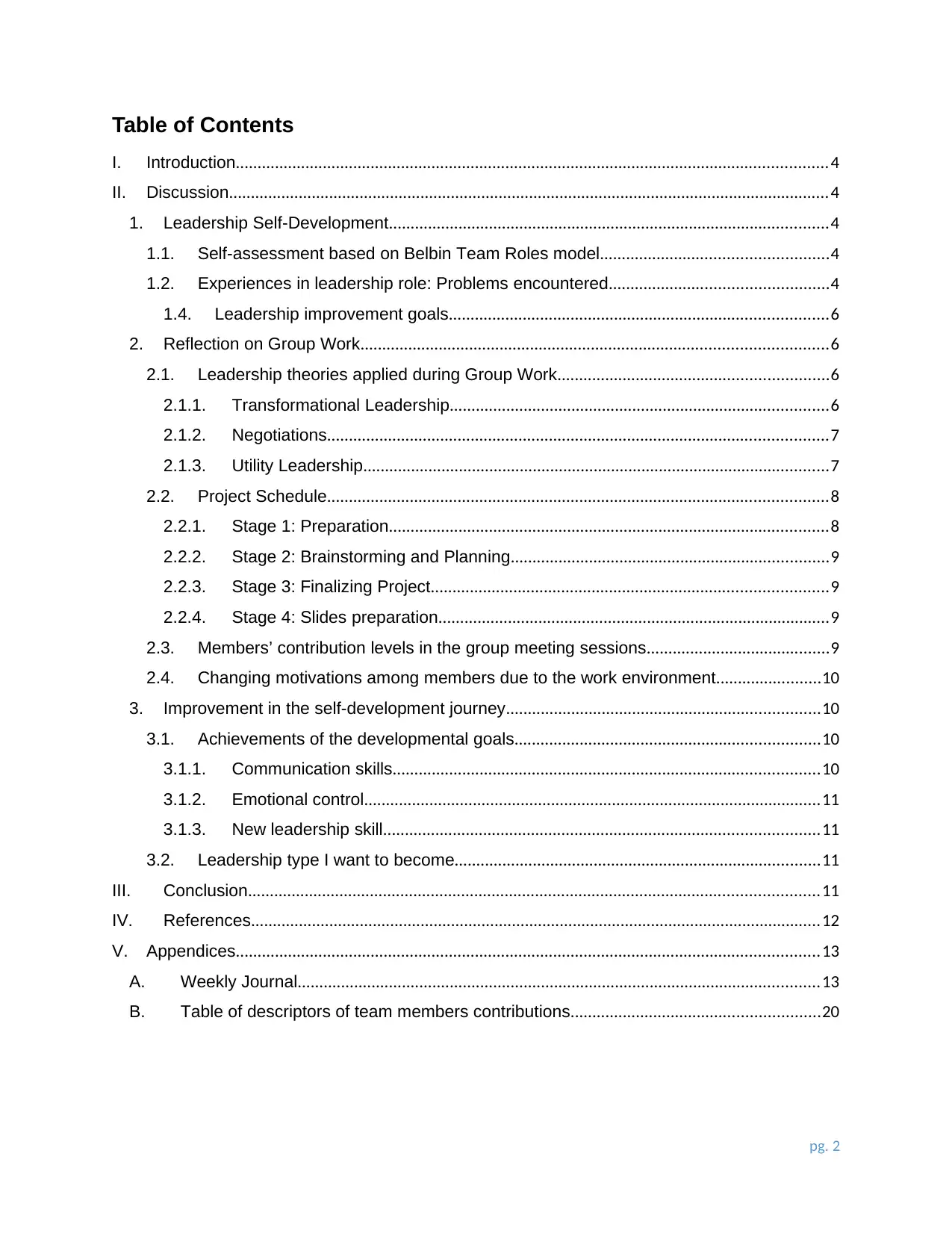
Table of Contents
I. Introduction........................................................................................................................................4
II. Discussion..........................................................................................................................................4
1. Leadership Self-Development.....................................................................................................4
1.1. Self-assessment based on Belbin Team Roles model....................................................4
1.2. Experiences in leadership role: Problems encountered..................................................4
1.4. Leadership improvement goals.......................................................................................6
2. Reflection on Group Work...........................................................................................................6
2.1. Leadership theories applied during Group Work..............................................................6
2.1.1. Transformational Leadership.......................................................................................6
2.1.2. Negotiations...................................................................................................................7
2.1.3. Utility Leadership...........................................................................................................7
2.2. Project Schedule...................................................................................................................8
2.2.1. Stage 1: Preparation.....................................................................................................8
2.2.2. Stage 2: Brainstorming and Planning.........................................................................9
2.2.3. Stage 3: Finalizing Project...........................................................................................9
2.2.4. Stage 4: Slides preparation..........................................................................................9
2.3. Members’ contribution levels in the group meeting sessions..........................................9
2.4. Changing motivations among members due to the work environment........................10
3. Improvement in the self-development journey........................................................................10
3.1. Achievements of the developmental goals......................................................................10
3.1.1. Communication skills..................................................................................................10
3.1.2. Emotional control.........................................................................................................11
3.1.3. New leadership skill....................................................................................................11
3.2. Leadership type I want to become....................................................................................11
III. Conclusion...................................................................................................................................11
IV. References...................................................................................................................................12
V. Appendices......................................................................................................................................13
A. Weekly Journal........................................................................................................................13
B. Table of descriptors of team members contributions.........................................................20
pg. 2
I. Introduction........................................................................................................................................4
II. Discussion..........................................................................................................................................4
1. Leadership Self-Development.....................................................................................................4
1.1. Self-assessment based on Belbin Team Roles model....................................................4
1.2. Experiences in leadership role: Problems encountered..................................................4
1.4. Leadership improvement goals.......................................................................................6
2. Reflection on Group Work...........................................................................................................6
2.1. Leadership theories applied during Group Work..............................................................6
2.1.1. Transformational Leadership.......................................................................................6
2.1.2. Negotiations...................................................................................................................7
2.1.3. Utility Leadership...........................................................................................................7
2.2. Project Schedule...................................................................................................................8
2.2.1. Stage 1: Preparation.....................................................................................................8
2.2.2. Stage 2: Brainstorming and Planning.........................................................................9
2.2.3. Stage 3: Finalizing Project...........................................................................................9
2.2.4. Stage 4: Slides preparation..........................................................................................9
2.3. Members’ contribution levels in the group meeting sessions..........................................9
2.4. Changing motivations among members due to the work environment........................10
3. Improvement in the self-development journey........................................................................10
3.1. Achievements of the developmental goals......................................................................10
3.1.1. Communication skills..................................................................................................10
3.1.2. Emotional control.........................................................................................................11
3.1.3. New leadership skill....................................................................................................11
3.2. Leadership type I want to become....................................................................................11
III. Conclusion...................................................................................................................................11
IV. References...................................................................................................................................12
V. Appendices......................................................................................................................................13
A. Weekly Journal........................................................................................................................13
B. Table of descriptors of team members contributions.........................................................20
pg. 2
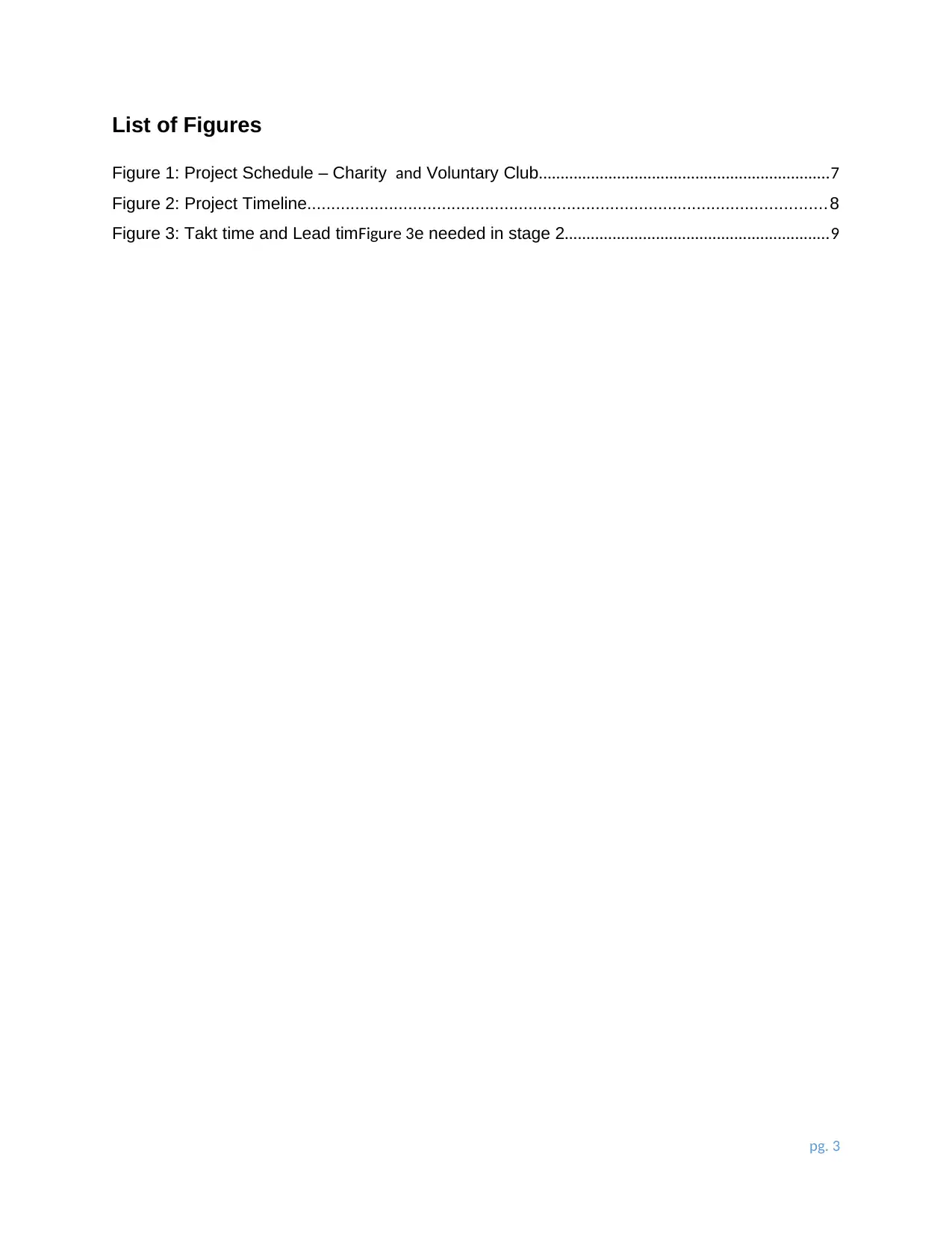
List of Figures
Figure 1: Project Schedule – Charity and Voluntary Club...................................................................7
Figure 2: Project Timeline............................................................................................................ 8
Figure 3: Takt time and Lead timFigure 3e needed in stage 2.............................................................9
pg. 3
Figure 1: Project Schedule – Charity and Voluntary Club...................................................................7
Figure 2: Project Timeline............................................................................................................ 8
Figure 3: Takt time and Lead timFigure 3e needed in stage 2.............................................................9
pg. 3
⊘ This is a preview!⊘
Do you want full access?
Subscribe today to unlock all pages.

Trusted by 1+ million students worldwide

I. Introduction
Leader has always been acknowledged as the people who are clever, wise and intelligent. From
the academic view, leadership is a long-term journey of practicing and training skills along with
the inner transformation. This reflective report will cover the leadership theories and my
experiences in the group work, to emphasize the growth, hindrances, and improvement points in
my development journey.
II. Discussion
1. Leadership Self-Development
This section will combine the analysis on my strengths and weaknesses as a leader, which will
comprise of four of the following parts. The first part is to analyze my team role based on
Belbin’s Model; the second part is to reflect to my experiences as a leader and the third part will
evaluate the problems I encountered. Finally, after a comprehensive analysis on my leadership
capacity, I will set the goals for the leadership development journey.
1.1. Self-assessment based on Belbin Team Roles model
Dr. Meredith Belbin, who is a researcher studying about team management, and his team
designed Belbin Team Roles model. Consequently, this discovery of Belbin helps people be
more understanding on their roles in a team. The model demonstrates nine roles, which include
Resource Investigator, Team worker, Coordinator, Plant, Monitor Evaluator, Specialist, Shaper,
Implementer and Completer Finisher perfectionism (Belbin | Engage and develop the talent
around you, n.d.). According to the Belin’s Team Roles test, my scores illustrated my role is to
be the “Completer”. The test analyzes the Completer as the one who follows the perfectionism
(Belbin | Engage and develop the talent around you, n.d.). Completers tend to have strong time
management skills, and they prioritize the accuracy as well as professionalism. Besides the
strengths, Completers’ weaknesses are to arouse unnecessary anxiety during the working
process. To be reflecting on my experiences in different groups, I tend to be the one who always
push the team on starting the project soon. Partially, I want my group to work professionally,
and no team members have to feel the pressure of time, as the pressure would easily
demotivate the group’s spirit during the working process.
pg. 4
Leader has always been acknowledged as the people who are clever, wise and intelligent. From
the academic view, leadership is a long-term journey of practicing and training skills along with
the inner transformation. This reflective report will cover the leadership theories and my
experiences in the group work, to emphasize the growth, hindrances, and improvement points in
my development journey.
II. Discussion
1. Leadership Self-Development
This section will combine the analysis on my strengths and weaknesses as a leader, which will
comprise of four of the following parts. The first part is to analyze my team role based on
Belbin’s Model; the second part is to reflect to my experiences as a leader and the third part will
evaluate the problems I encountered. Finally, after a comprehensive analysis on my leadership
capacity, I will set the goals for the leadership development journey.
1.1. Self-assessment based on Belbin Team Roles model
Dr. Meredith Belbin, who is a researcher studying about team management, and his team
designed Belbin Team Roles model. Consequently, this discovery of Belbin helps people be
more understanding on their roles in a team. The model demonstrates nine roles, which include
Resource Investigator, Team worker, Coordinator, Plant, Monitor Evaluator, Specialist, Shaper,
Implementer and Completer Finisher perfectionism (Belbin | Engage and develop the talent
around you, n.d.). According to the Belin’s Team Roles test, my scores illustrated my role is to
be the “Completer”. The test analyzes the Completer as the one who follows the perfectionism
(Belbin | Engage and develop the talent around you, n.d.). Completers tend to have strong time
management skills, and they prioritize the accuracy as well as professionalism. Besides the
strengths, Completers’ weaknesses are to arouse unnecessary anxiety during the working
process. To be reflecting on my experiences in different groups, I tend to be the one who always
push the team on starting the project soon. Partially, I want my group to work professionally,
and no team members have to feel the pressure of time, as the pressure would easily
demotivate the group’s spirit during the working process.
pg. 4
Paraphrase This Document
Need a fresh take? Get an instant paraphrase of this document with our AI Paraphraser
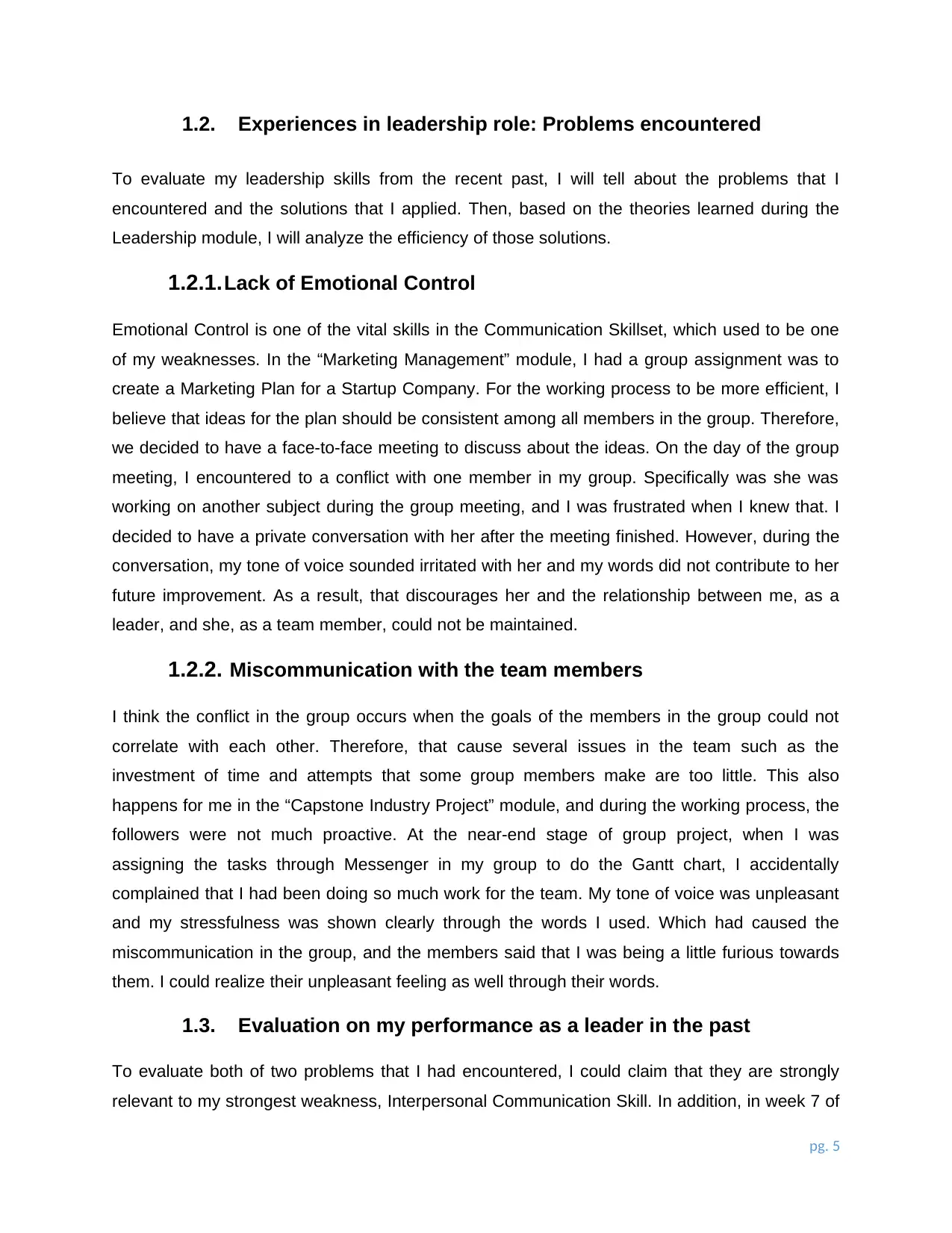
1.2. Experiences in leadership role: Problems encountered
To evaluate my leadership skills from the recent past, I will tell about the problems that I
encountered and the solutions that I applied. Then, based on the theories learned during the
Leadership module, I will analyze the efficiency of those solutions.
1.2.1.Lack of Emotional Control
Emotional Control is one of the vital skills in the Communication Skillset, which used to be one
of my weaknesses. In the “Marketing Management” module, I had a group assignment was to
create a Marketing Plan for a Startup Company. For the working process to be more efficient, I
believe that ideas for the plan should be consistent among all members in the group. Therefore,
we decided to have a face-to-face meeting to discuss about the ideas. On the day of the group
meeting, I encountered to a conflict with one member in my group. Specifically was she was
working on another subject during the group meeting, and I was frustrated when I knew that. I
decided to have a private conversation with her after the meeting finished. However, during the
conversation, my tone of voice sounded irritated with her and my words did not contribute to her
future improvement. As a result, that discourages her and the relationship between me, as a
leader, and she, as a team member, could not be maintained.
1.2.2. Miscommunication with the team members
I think the conflict in the group occurs when the goals of the members in the group could not
correlate with each other. Therefore, that cause several issues in the team such as the
investment of time and attempts that some group members make are too little. This also
happens for me in the “Capstone Industry Project” module, and during the working process, the
followers were not much proactive. At the near-end stage of group project, when I was
assigning the tasks through Messenger in my group to do the Gantt chart, I accidentally
complained that I had been doing so much work for the team. My tone of voice was unpleasant
and my stressfulness was shown clearly through the words I used. Which had caused the
miscommunication in the group, and the members said that I was being a little furious towards
them. I could realize their unpleasant feeling as well through their words.
1.3. Evaluation on my performance as a leader in the past
To evaluate both of two problems that I had encountered, I could claim that they are strongly
relevant to my strongest weakness, Interpersonal Communication Skill. In addition, in week 7 of
pg. 5
To evaluate my leadership skills from the recent past, I will tell about the problems that I
encountered and the solutions that I applied. Then, based on the theories learned during the
Leadership module, I will analyze the efficiency of those solutions.
1.2.1.Lack of Emotional Control
Emotional Control is one of the vital skills in the Communication Skillset, which used to be one
of my weaknesses. In the “Marketing Management” module, I had a group assignment was to
create a Marketing Plan for a Startup Company. For the working process to be more efficient, I
believe that ideas for the plan should be consistent among all members in the group. Therefore,
we decided to have a face-to-face meeting to discuss about the ideas. On the day of the group
meeting, I encountered to a conflict with one member in my group. Specifically was she was
working on another subject during the group meeting, and I was frustrated when I knew that. I
decided to have a private conversation with her after the meeting finished. However, during the
conversation, my tone of voice sounded irritated with her and my words did not contribute to her
future improvement. As a result, that discourages her and the relationship between me, as a
leader, and she, as a team member, could not be maintained.
1.2.2. Miscommunication with the team members
I think the conflict in the group occurs when the goals of the members in the group could not
correlate with each other. Therefore, that cause several issues in the team such as the
investment of time and attempts that some group members make are too little. This also
happens for me in the “Capstone Industry Project” module, and during the working process, the
followers were not much proactive. At the near-end stage of group project, when I was
assigning the tasks through Messenger in my group to do the Gantt chart, I accidentally
complained that I had been doing so much work for the team. My tone of voice was unpleasant
and my stressfulness was shown clearly through the words I used. Which had caused the
miscommunication in the group, and the members said that I was being a little furious towards
them. I could realize their unpleasant feeling as well through their words.
1.3. Evaluation on my performance as a leader in the past
To evaluate both of two problems that I had encountered, I could claim that they are strongly
relevant to my strongest weakness, Interpersonal Communication Skill. In addition, in week 7 of
pg. 5

this module, I was required to take the “Interpersonal Communication Skills Test” on the UoG
Moodle. My score was 54 per 100, which was considered average communication skills. In
week 8 of the module, I took the test again and my result had an increase, it was 69 per 100.
Experiences from being leaders managing the team to achieve good scores on the project had
helped me a lots in discovering my weaknesses and searching for improvement.
1.4. Leadership improvement goals
According to the “Leadership Development” lecture in the module, self-development path is
correlated with the leadership development path (Emery, 2021). Therefore, I would mainly
concentrate on improving the following goals:
Improve my communication skill
Acquire new leadership skills and always aim to the efficiency
Practice controlling my emotion.
2. Reflection on Group Work
In this section, there are four parts. Firstly, I will refer to the “leadership theories” that we had
been using during the group work; secondly, I will illustrate the “project schedule”, so the third
part, it would be more obvious when I analyze the “members’ contribution level”. The final part is
my evaluation on the “changing goals” of group members due to the work environment.
2.1. Leadership theories applied during Group Work
During the “Leadership in Organization” module, three main theories had been applied as the
basis knowledge for the leader, and the tools to enhance the productivity and efficiency for the
team members. Three theories, which will be illustrated below, include “Transformational
Leadership”, “Negotiations”, and “Utility Leadership”.
2.1.1.Transformational Leadership
As a leader, I could aware that my team members have high capacity and responsibility, which
would make it possible for the implementation of “Transformational Leadership” theory.
Furthermore, this module is about “Leadership Development in Organization”, so the
responsibility of the leader is to facilitate and reinforce development among individuals in the
group throughout teamwork process. The theory of the “Transformational Leadership” illustrates
the leaders who focus on influencing the followers and encourage them to show the potential
pg. 6
Moodle. My score was 54 per 100, which was considered average communication skills. In
week 8 of the module, I took the test again and my result had an increase, it was 69 per 100.
Experiences from being leaders managing the team to achieve good scores on the project had
helped me a lots in discovering my weaknesses and searching for improvement.
1.4. Leadership improvement goals
According to the “Leadership Development” lecture in the module, self-development path is
correlated with the leadership development path (Emery, 2021). Therefore, I would mainly
concentrate on improving the following goals:
Improve my communication skill
Acquire new leadership skills and always aim to the efficiency
Practice controlling my emotion.
2. Reflection on Group Work
In this section, there are four parts. Firstly, I will refer to the “leadership theories” that we had
been using during the group work; secondly, I will illustrate the “project schedule”, so the third
part, it would be more obvious when I analyze the “members’ contribution level”. The final part is
my evaluation on the “changing goals” of group members due to the work environment.
2.1. Leadership theories applied during Group Work
During the “Leadership in Organization” module, three main theories had been applied as the
basis knowledge for the leader, and the tools to enhance the productivity and efficiency for the
team members. Three theories, which will be illustrated below, include “Transformational
Leadership”, “Negotiations”, and “Utility Leadership”.
2.1.1.Transformational Leadership
As a leader, I could aware that my team members have high capacity and responsibility, which
would make it possible for the implementation of “Transformational Leadership” theory.
Furthermore, this module is about “Leadership Development in Organization”, so the
responsibility of the leader is to facilitate and reinforce development among individuals in the
group throughout teamwork process. The theory of the “Transformational Leadership” illustrates
the leaders who focus on influencing the followers and encourage them to show the potential
pg. 6
⊘ This is a preview!⊘
Do you want full access?
Subscribe today to unlock all pages.

Trusted by 1+ million students worldwide
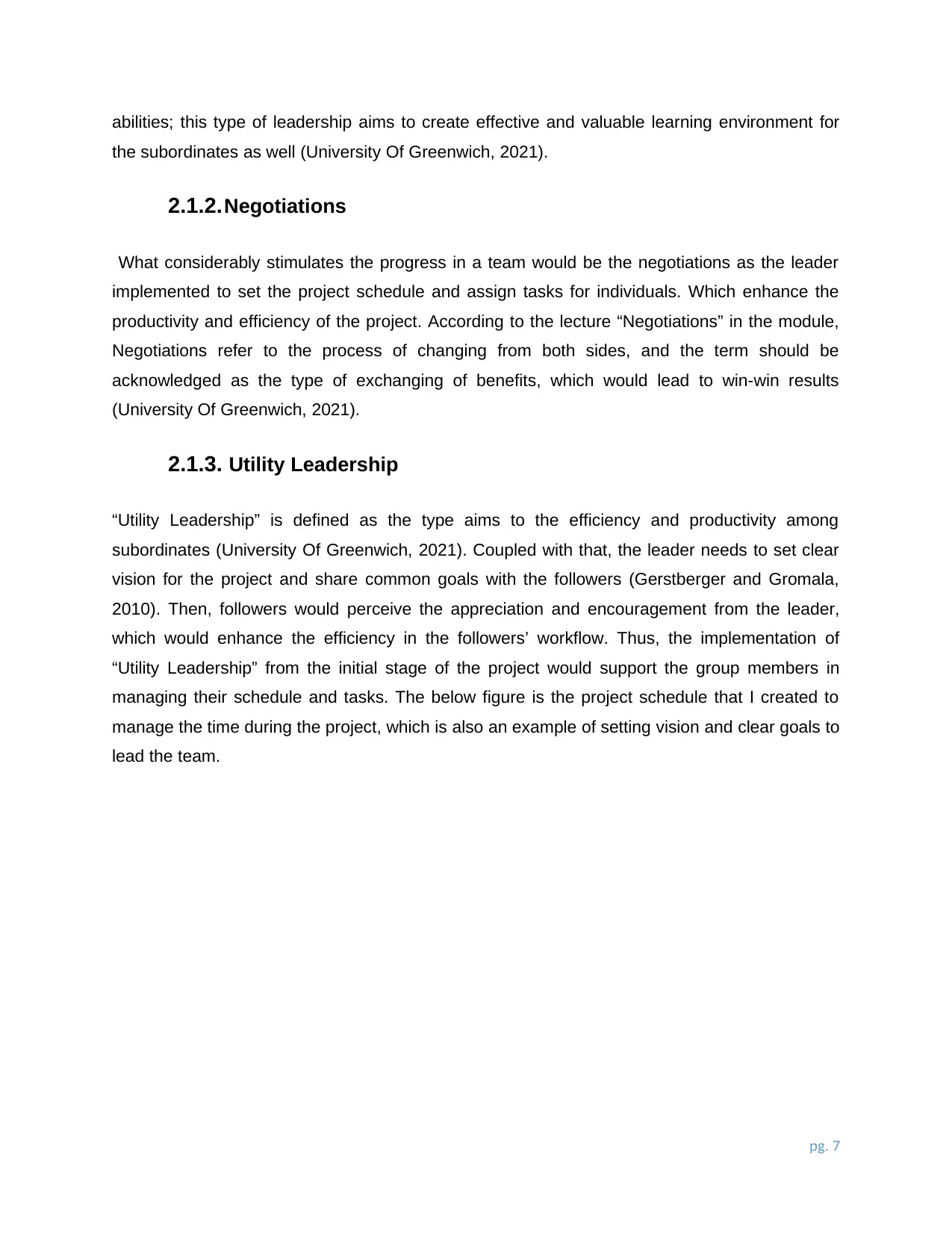
abilities; this type of leadership aims to create effective and valuable learning environment for
the subordinates as well (University Of Greenwich, 2021).
2.1.2.Negotiations
What considerably stimulates the progress in a team would be the negotiations as the leader
implemented to set the project schedule and assign tasks for individuals. Which enhance the
productivity and efficiency of the project. According to the lecture “Negotiations” in the module,
Negotiations refer to the process of changing from both sides, and the term should be
acknowledged as the type of exchanging of benefits, which would lead to win-win results
(University Of Greenwich, 2021).
2.1.3. Utility Leadership
“Utility Leadership” is defined as the type aims to the efficiency and productivity among
subordinates (University Of Greenwich, 2021). Coupled with that, the leader needs to set clear
vision for the project and share common goals with the followers (Gerstberger and Gromala,
2010). Then, followers would perceive the appreciation and encouragement from the leader,
which would enhance the efficiency in the followers’ workflow. Thus, the implementation of
“Utility Leadership” from the initial stage of the project would support the group members in
managing their schedule and tasks. The below figure is the project schedule that I created to
manage the time during the project, which is also an example of setting vision and clear goals to
lead the team.
pg. 7
the subordinates as well (University Of Greenwich, 2021).
2.1.2.Negotiations
What considerably stimulates the progress in a team would be the negotiations as the leader
implemented to set the project schedule and assign tasks for individuals. Which enhance the
productivity and efficiency of the project. According to the lecture “Negotiations” in the module,
Negotiations refer to the process of changing from both sides, and the term should be
acknowledged as the type of exchanging of benefits, which would lead to win-win results
(University Of Greenwich, 2021).
2.1.3. Utility Leadership
“Utility Leadership” is defined as the type aims to the efficiency and productivity among
subordinates (University Of Greenwich, 2021). Coupled with that, the leader needs to set clear
vision for the project and share common goals with the followers (Gerstberger and Gromala,
2010). Then, followers would perceive the appreciation and encouragement from the leader,
which would enhance the efficiency in the followers’ workflow. Thus, the implementation of
“Utility Leadership” from the initial stage of the project would support the group members in
managing their schedule and tasks. The below figure is the project schedule that I created to
manage the time during the project, which is also an example of setting vision and clear goals to
lead the team.
pg. 7
Paraphrase This Document
Need a fresh take? Get an instant paraphrase of this document with our AI Paraphraser
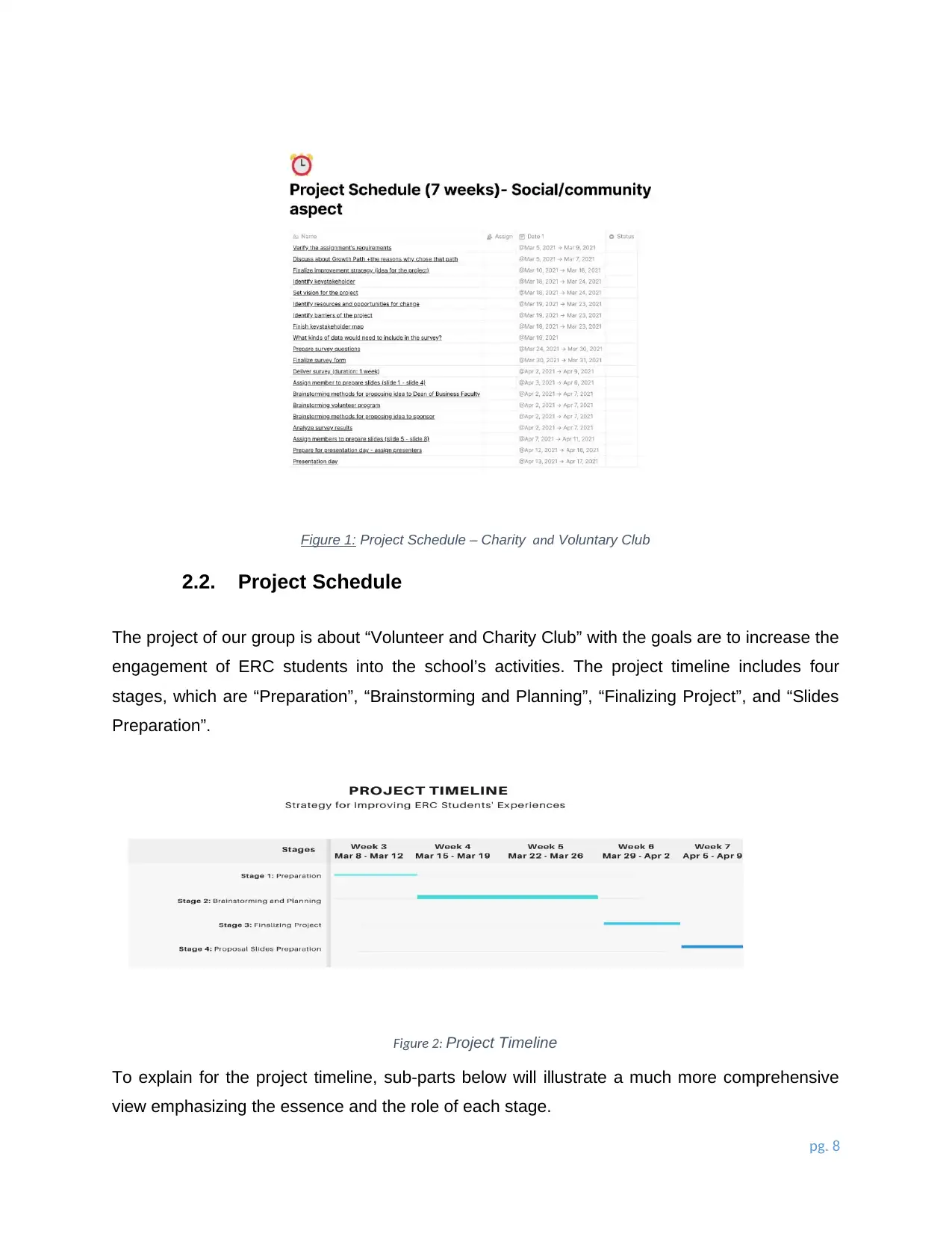
Figure 1: Project Schedule – Charity and Voluntary Club
2.2. Project Schedule
The project of our group is about “Volunteer and Charity Club” with the goals are to increase the
engagement of ERC students into the school’s activities. The project timeline includes four
stages, which are “Preparation”, “Brainstorming and Planning”, “Finalizing Project”, and “Slides
Preparation”.
Figure 2: Project Timeline
To explain for the project timeline, sub-parts below will illustrate a much more comprehensive
view emphasizing the essence and the role of each stage.
pg. 8
2.2. Project Schedule
The project of our group is about “Volunteer and Charity Club” with the goals are to increase the
engagement of ERC students into the school’s activities. The project timeline includes four
stages, which are “Preparation”, “Brainstorming and Planning”, “Finalizing Project”, and “Slides
Preparation”.
Figure 2: Project Timeline
To explain for the project timeline, sub-parts below will illustrate a much more comprehensive
view emphasizing the essence and the role of each stage.
pg. 8
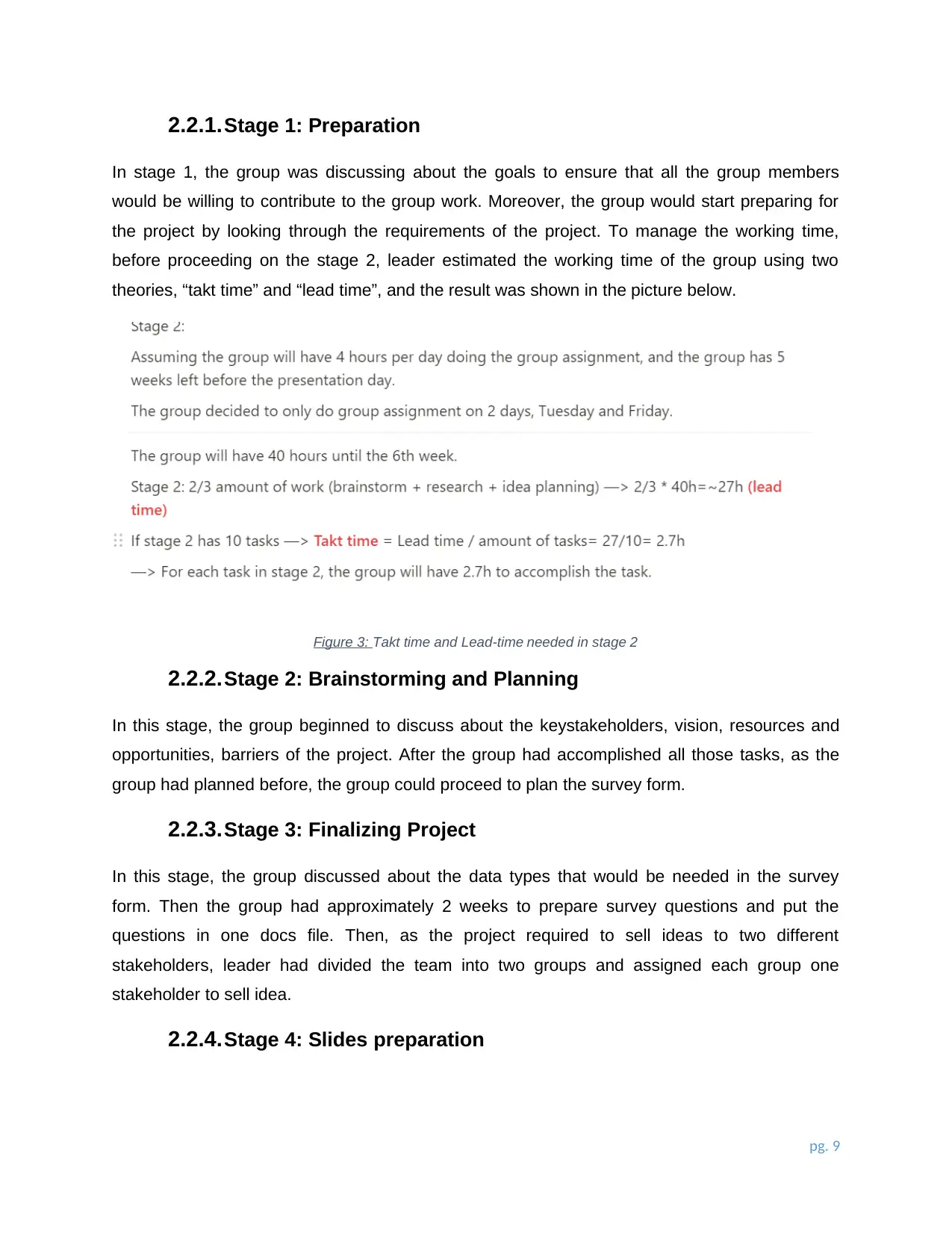
2.2.1.Stage 1: Preparation
In stage 1, the group was discussing about the goals to ensure that all the group members
would be willing to contribute to the group work. Moreover, the group would start preparing for
the project by looking through the requirements of the project. To manage the working time,
before proceeding on the stage 2, leader estimated the working time of the group using two
theories, “takt time” and “lead time”, and the result was shown in the picture below.
Figure 3: Takt time and Lead-time needed in stage 2
2.2.2.Stage 2: Brainstorming and Planning
In this stage, the group beginned to discuss about the keystakeholders, vision, resources and
opportunities, barriers of the project. After the group had accomplished all those tasks, as the
group had planned before, the group could proceed to plan the survey form.
2.2.3.Stage 3: Finalizing Project
In this stage, the group discussed about the data types that would be needed in the survey
form. Then the group had approximately 2 weeks to prepare survey questions and put the
questions in one docs file. Then, as the project required to sell ideas to two different
stakeholders, leader had divided the team into two groups and assigned each group one
stakeholder to sell idea.
2.2.4.Stage 4: Slides preparation
pg. 9
In stage 1, the group was discussing about the goals to ensure that all the group members
would be willing to contribute to the group work. Moreover, the group would start preparing for
the project by looking through the requirements of the project. To manage the working time,
before proceeding on the stage 2, leader estimated the working time of the group using two
theories, “takt time” and “lead time”, and the result was shown in the picture below.
Figure 3: Takt time and Lead-time needed in stage 2
2.2.2.Stage 2: Brainstorming and Planning
In this stage, the group beginned to discuss about the keystakeholders, vision, resources and
opportunities, barriers of the project. After the group had accomplished all those tasks, as the
group had planned before, the group could proceed to plan the survey form.
2.2.3.Stage 3: Finalizing Project
In this stage, the group discussed about the data types that would be needed in the survey
form. Then the group had approximately 2 weeks to prepare survey questions and put the
questions in one docs file. Then, as the project required to sell ideas to two different
stakeholders, leader had divided the team into two groups and assigned each group one
stakeholder to sell idea.
2.2.4.Stage 4: Slides preparation
pg. 9
⊘ This is a preview!⊘
Do you want full access?
Subscribe today to unlock all pages.

Trusted by 1+ million students worldwide

Proceeding on this stage, the group had accomplished all the ideas planning parts, and
beginned to prepare slides for the proposal. Leader assigned one member whom was proficient
in making and designing slides to manage this stage. That member would have to decide the
concept of the slides, then check the quality as well as the appropriate of other members’ slides.
2.3. Members’ contribution levels in the group meeting sessions
Throughout the project, the group had five group meeting sessions. Before every meeting,
leader assigned tasks for individuals to prepare for the upcoming meeting session, which would
increase the effectiveness and utilize the available time of the members. In all the meeting
sessions, most of the group members illustrate professional work and behavior. Notably, two
members in the group are considerably knowledgeable; they demonstrated professionalism
throughout the project. In addition, these two members have gained extensive experiences in
the field of coordinating and organizing a voluntary club. Although other members do not have
many experiences in the field, they were dedicated to develop and improve the quality of the
project.
2.4. Changing motivations among members due to the work
environment
As mentioned in “week 3” of “reflective journal”, my motivation in the project was to encourage
the professionalism in teamwork. Comparing with other members’ motivations, the common
motivation was to pass the course. However, according to my experiences in the group, I could
emphasize that the members’ behaviors were opposed to those personal motivations. As
mentioned above, all of the team members had shown dedication and made large contribution
to the group work. Furthermore, as a leader, the requirement for the project being practical and
detailed were gladly embraced and effectively progressed by the group. Thus, I could claim that
motivations of individuals could be changed if they perceived certain amount of encouragement
and worked in a professional environment.
3. Improvement in the self-development journey
In this section, I will mention and analysis my achievement on the goals that I have set. Then,
based on my improvement and objectives, I will set the leadership type that I aim to proceed on
the development for that type in a long-term journey.
pg. 10
beginned to prepare slides for the proposal. Leader assigned one member whom was proficient
in making and designing slides to manage this stage. That member would have to decide the
concept of the slides, then check the quality as well as the appropriate of other members’ slides.
2.3. Members’ contribution levels in the group meeting sessions
Throughout the project, the group had five group meeting sessions. Before every meeting,
leader assigned tasks for individuals to prepare for the upcoming meeting session, which would
increase the effectiveness and utilize the available time of the members. In all the meeting
sessions, most of the group members illustrate professional work and behavior. Notably, two
members in the group are considerably knowledgeable; they demonstrated professionalism
throughout the project. In addition, these two members have gained extensive experiences in
the field of coordinating and organizing a voluntary club. Although other members do not have
many experiences in the field, they were dedicated to develop and improve the quality of the
project.
2.4. Changing motivations among members due to the work
environment
As mentioned in “week 3” of “reflective journal”, my motivation in the project was to encourage
the professionalism in teamwork. Comparing with other members’ motivations, the common
motivation was to pass the course. However, according to my experiences in the group, I could
emphasize that the members’ behaviors were opposed to those personal motivations. As
mentioned above, all of the team members had shown dedication and made large contribution
to the group work. Furthermore, as a leader, the requirement for the project being practical and
detailed were gladly embraced and effectively progressed by the group. Thus, I could claim that
motivations of individuals could be changed if they perceived certain amount of encouragement
and worked in a professional environment.
3. Improvement in the self-development journey
In this section, I will mention and analysis my achievement on the goals that I have set. Then,
based on my improvement and objectives, I will set the leadership type that I aim to proceed on
the development for that type in a long-term journey.
pg. 10
Paraphrase This Document
Need a fresh take? Get an instant paraphrase of this document with our AI Paraphraser
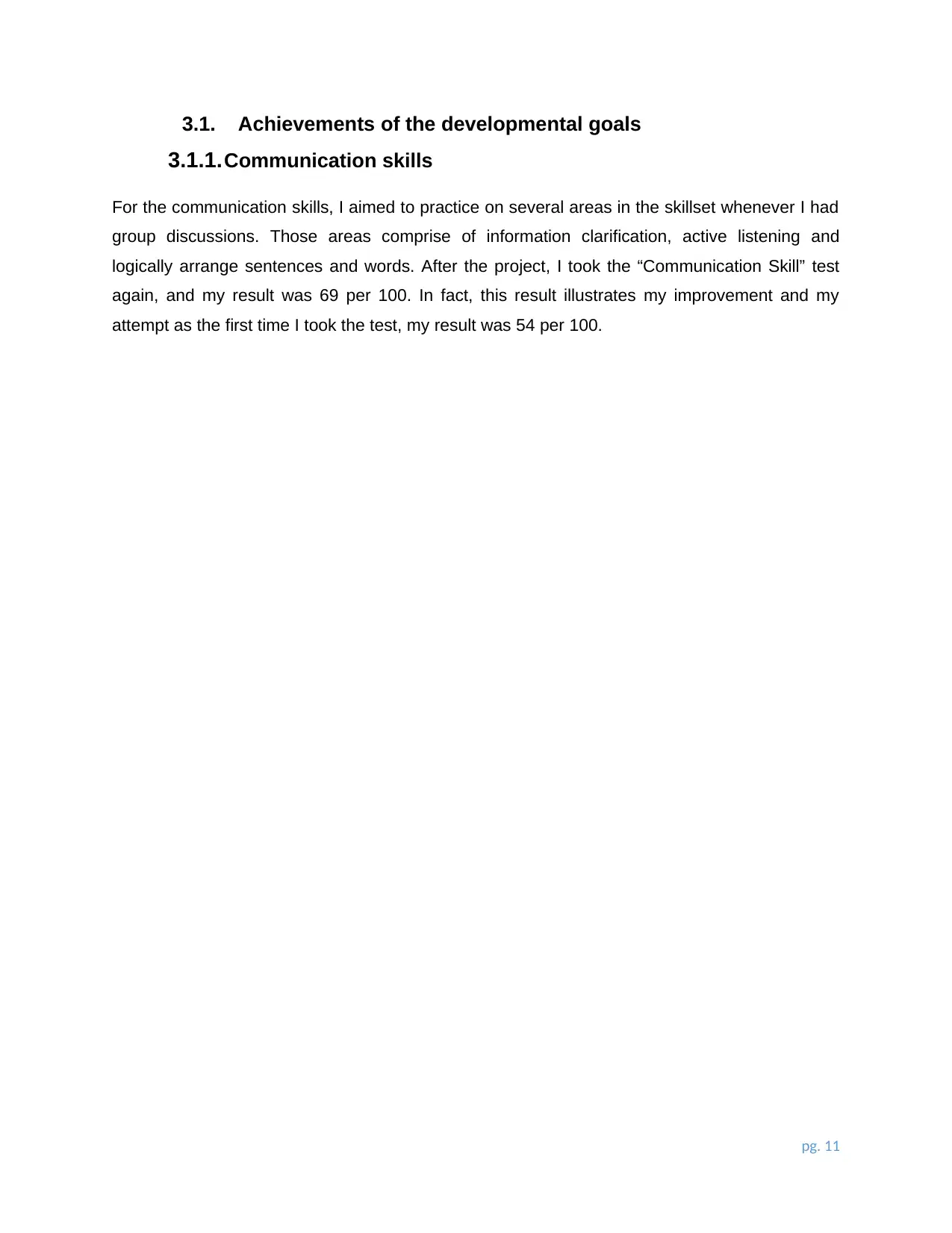
3.1. Achievements of the developmental goals
3.1.1.Communication skills
For the communication skills, I aimed to practice on several areas in the skillset whenever I had
group discussions. Those areas comprise of information clarification, active listening and
logically arrange sentences and words. After the project, I took the “Communication Skill” test
again, and my result was 69 per 100. In fact, this result illustrates my improvement and my
attempt as the first time I took the test, my result was 54 per 100.
pg. 11
3.1.1.Communication skills
For the communication skills, I aimed to practice on several areas in the skillset whenever I had
group discussions. Those areas comprise of information clarification, active listening and
logically arrange sentences and words. After the project, I took the “Communication Skill” test
again, and my result was 69 per 100. In fact, this result illustrates my improvement and my
attempt as the first time I took the test, my result was 54 per 100.
pg. 11
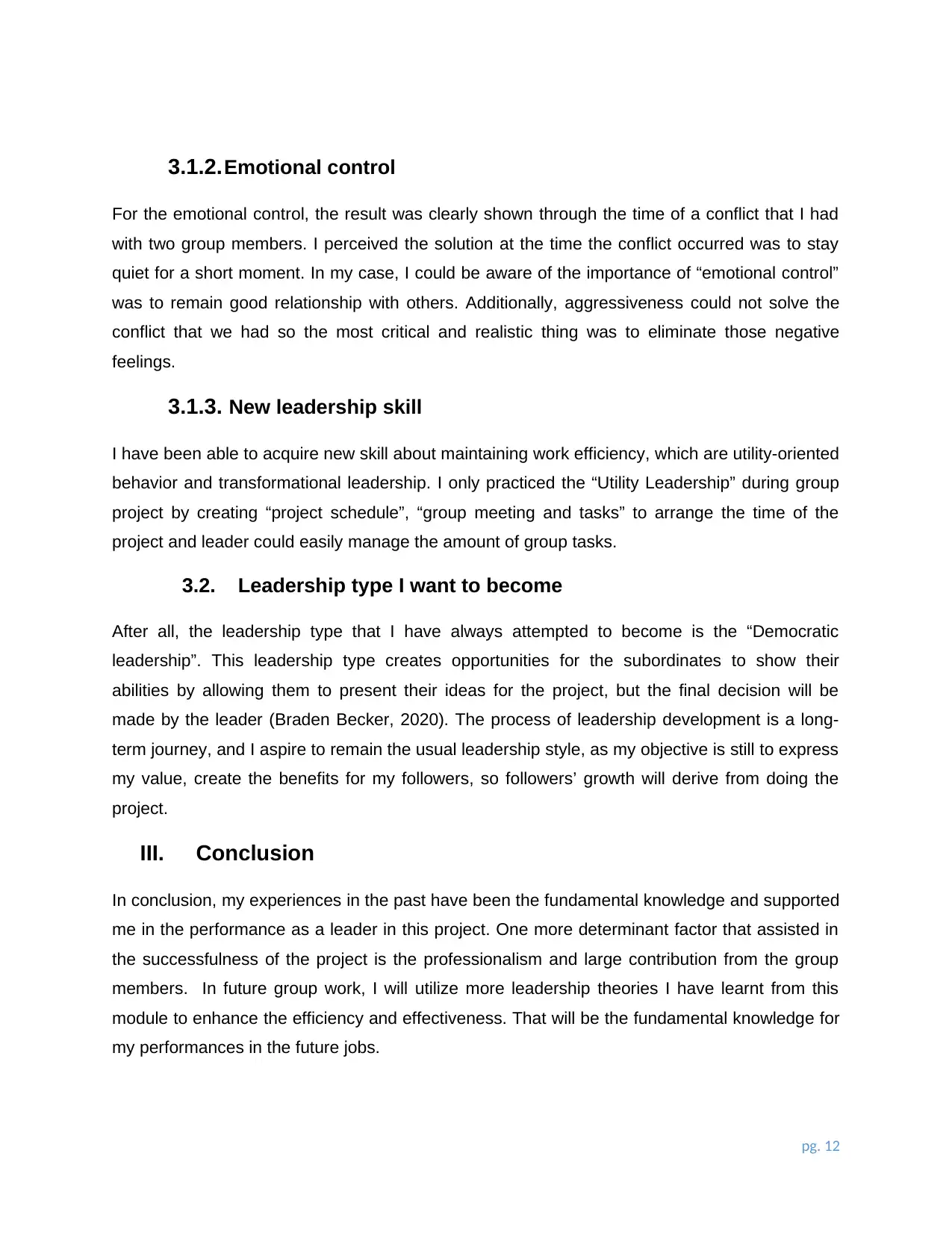
3.1.2.Emotional control
For the emotional control, the result was clearly shown through the time of a conflict that I had
with two group members. I perceived the solution at the time the conflict occurred was to stay
quiet for a short moment. In my case, I could be aware of the importance of “emotional control”
was to remain good relationship with others. Additionally, aggressiveness could not solve the
conflict that we had so the most critical and realistic thing was to eliminate those negative
feelings.
3.1.3. New leadership skill
I have been able to acquire new skill about maintaining work efficiency, which are utility-oriented
behavior and transformational leadership. I only practiced the “Utility Leadership” during group
project by creating “project schedule”, “group meeting and tasks” to arrange the time of the
project and leader could easily manage the amount of group tasks.
3.2. Leadership type I want to become
After all, the leadership type that I have always attempted to become is the “Democratic
leadership”. This leadership type creates opportunities for the subordinates to show their
abilities by allowing them to present their ideas for the project, but the final decision will be
made by the leader (Braden Becker, 2020). The process of leadership development is a long-
term journey, and I aspire to remain the usual leadership style, as my objective is still to express
my value, create the benefits for my followers, so followers’ growth will derive from doing the
project.
III. Conclusion
In conclusion, my experiences in the past have been the fundamental knowledge and supported
me in the performance as a leader in this project. One more determinant factor that assisted in
the successfulness of the project is the professionalism and large contribution from the group
members. In future group work, I will utilize more leadership theories I have learnt from this
module to enhance the efficiency and effectiveness. That will be the fundamental knowledge for
my performances in the future jobs.
pg. 12
For the emotional control, the result was clearly shown through the time of a conflict that I had
with two group members. I perceived the solution at the time the conflict occurred was to stay
quiet for a short moment. In my case, I could be aware of the importance of “emotional control”
was to remain good relationship with others. Additionally, aggressiveness could not solve the
conflict that we had so the most critical and realistic thing was to eliminate those negative
feelings.
3.1.3. New leadership skill
I have been able to acquire new skill about maintaining work efficiency, which are utility-oriented
behavior and transformational leadership. I only practiced the “Utility Leadership” during group
project by creating “project schedule”, “group meeting and tasks” to arrange the time of the
project and leader could easily manage the amount of group tasks.
3.2. Leadership type I want to become
After all, the leadership type that I have always attempted to become is the “Democratic
leadership”. This leadership type creates opportunities for the subordinates to show their
abilities by allowing them to present their ideas for the project, but the final decision will be
made by the leader (Braden Becker, 2020). The process of leadership development is a long-
term journey, and I aspire to remain the usual leadership style, as my objective is still to express
my value, create the benefits for my followers, so followers’ growth will derive from doing the
project.
III. Conclusion
In conclusion, my experiences in the past have been the fundamental knowledge and supported
me in the performance as a leader in this project. One more determinant factor that assisted in
the successfulness of the project is the professionalism and large contribution from the group
members. In future group work, I will utilize more leadership theories I have learnt from this
module to enhance the efficiency and effectiveness. That will be the fundamental knowledge for
my performances in the future jobs.
pg. 12
⊘ This is a preview!⊘
Do you want full access?
Subscribe today to unlock all pages.

Trusted by 1+ million students worldwide
1 out of 22
Related Documents
Your All-in-One AI-Powered Toolkit for Academic Success.
+13062052269
info@desklib.com
Available 24*7 on WhatsApp / Email
![[object Object]](/_next/static/media/star-bottom.7253800d.svg)
Unlock your academic potential
Copyright © 2020–2025 A2Z Services. All Rights Reserved. Developed and managed by ZUCOL.





